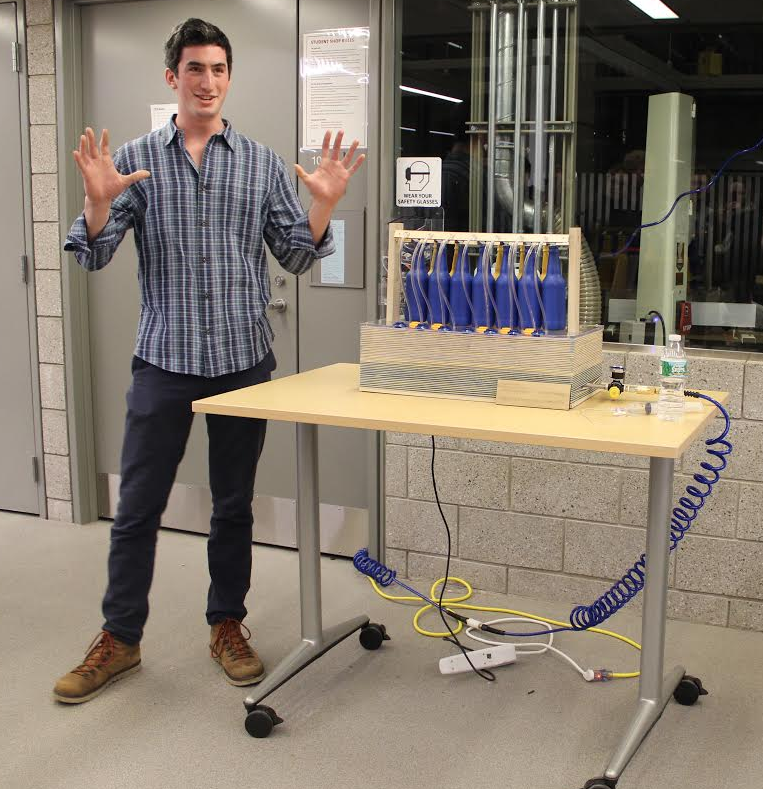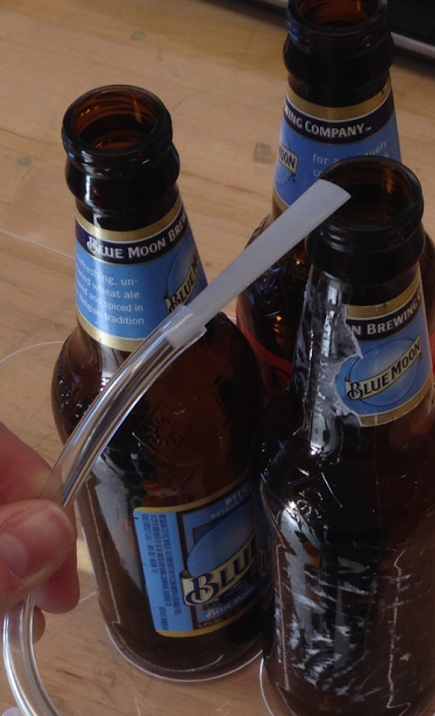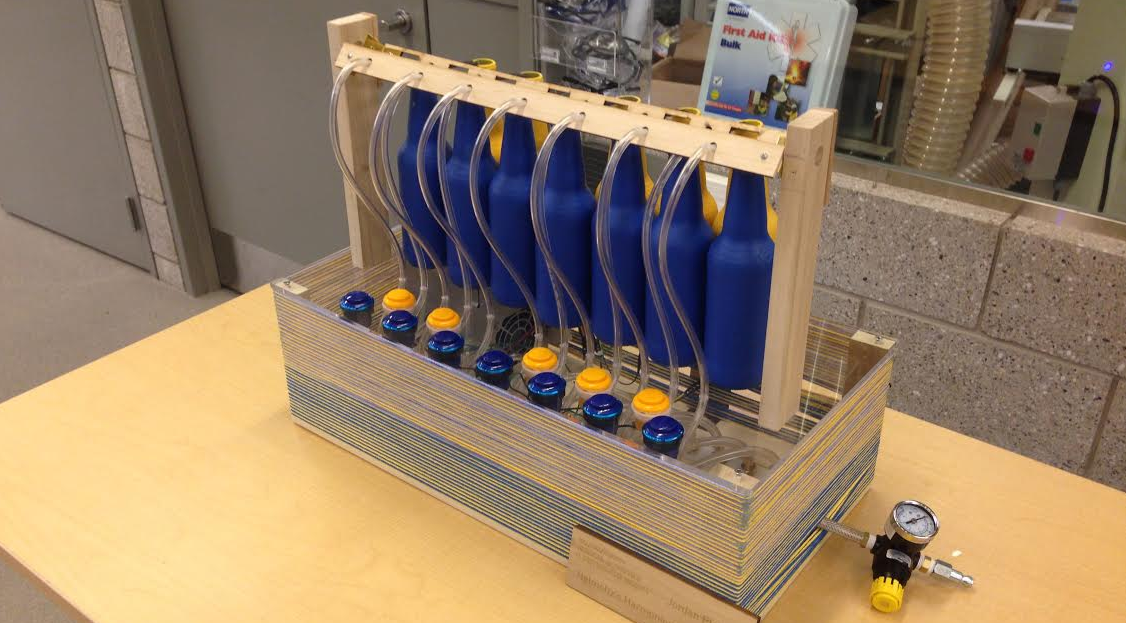As we have seen in the past, musicians have adopted 3D printing in numerous ways, printing instruments, records, and even using the sounds of a 3D printer as the beat for a song. There is no doubt that the musical community will continue to discover and embrace new applications for this incredible technology.
In fact, one man from London, who is currently attending Yale University, named Jordan Plotner, has used 3D printing to create what is probably one of the most intriguing musical instruments I have ever seen.
We have all blown air into a soda or beer bottle before. There’s actually entire musical performances on YouTube which rely solely on bottles filled with varying amounts of liquid producing different musical notes. The concept here is certainly not foreign to most of us.
Plotner, however, took the idea to the next level, creating what best could be described as a bottle keyboard. Working as a composer, and scoring films for several directors in Los Angeles, with credits ranging from Law & Order to Gossip Girl, Plotner certainly understands the importance of novelty when it comes to creating his own compositions.
“I decided to build an instrument with a familiar yet distinctive sound that I could then incorporate into my own musical compositions,” explained Plotner to 3DPrint.com. “I set out to build a keyboard instrument that created sound by blowing air across tuned beer bottles.”
The instrument consists of 12 beer bottles, which are set up in 2 rows, one consisting of 7 bottles and the other 5. He decided to use compressed air as the source of the sound, because of the ability to regulate the air flow, as well as the endless supply that’s available. There was one problem, however. When Plotner placed the nozzle of the compressed air up to the mouth of a bottle it didn’t sound anything like the sounds produced when a human blows air into a bottle; instead only the high harmonics were being excited. Plotner quickly realized what the problem was.
“This could be attributed to the speed and shape of the air nozzle,” he explained. “Because the velocity of air passing through a tube increases as the tube’s diameter decreases, the air flowed at a high speed through the small diameter of the compressed air nozzle, which caused the spring-like air compression in the bottle to generate a series of high frequencies. Therefore, my task was to find a way to use this compressed air to generate the full range of frequencies created when blowing across the bottle.”
Plotner realized that in order to blow the compressed air into the bottles in a similar fashion as a human would, he would need to shape the opening at the end of the nozzle in a way that is identical to that of an opening created by a human’s mouth. To do this he took several pictures of himself blowing air into the bottles. He then used SolidWorks to model the opening for each ‘mouthpiece’. Once modeled he used an Stratasys Objet 30Pro 3D printer to print out 12 of these nozzle attachments. The problem was solved!
Now he had to do was figure out how to trigger the release of air into each bottle. He used 12 solenoid valves which were connected to 12 different old arcade video game buttons. When the buttons are pressed the air is released to the nozzle attachment which it is connected to, ultimately flowing into a specific bottle, and producing a specific sound. Now all that was left was to put it all together.
“Using CorelDraw, I laser-cut my keyboard surface onto a sheet of acrylic,” Plotner told us. “I then connected the push buttons onto the acrylic surface and went on to complete the wiring for all of the solenoid valves. I went on to build the rest of the support structure, and finally filled the bottles with varying amounts of water to produce the pitch associated with its corresponding note on the keyboard. The color choice of the instrument was for purely aesthetic value, but I later realized that it would work well in a commercial jingle for an Ikea product.”
Without 3D printing there would have been no other way possible for Plotner to achieve his goal of creating this beer bottle keyboard, which is able to put out the same sounds produced when a human blows into a bottle.
“3D printing enabled me to physically create a very specific design with great precision that contributed largely to the ultimate success of the instrument,” he explained. “It would have been a great struggle creating these pieces without the Objet 30Pro.”
Let’s hear your thoughts on this incredible instrument in the 3D printed Beer Bottle Keyboard forum thread on 3DPB.com. Check out the short clip below showing Plotner playing around with his creation:

Subscribe to Our Email Newsletter
Stay up-to-date on all the latest news from the 3D printing industry and receive information and offers from third party vendors.
Print Services
Upload your 3D Models and get them printed quickly and efficiently.
You May Also Like
U.S. Navy Lab Uses 3D Printing to Reduce Tooling Lead Time By Over 90%
The F-35 Lightning II Joint Program Office (JPO), responsible for life-cycle management of the key fifth-generation joint strike fighter (JSF) system used by the U.S., its allies, and its partners,...
Etsy Design Rule Change Reduces Selection of 3D Printed Goods
Online marketplace Etsy has implemented a rule change requiring all 3D printed goods on the site to be original designs. The update to the site’s Creativity Standards states, ¨Items produced using...
Honeywell Qualifies 6K Additive’s Nickel 718 for 3D Printed Aerospace & Defense Parts
6K Additive is renowned for manufacturing sustainable additive manufacturing (AM) powder, and offers a wide portfolio of premium metal and alloy powders that include titanium, copper, stainless steel, and nickel,...
MetalWorm Sells WAAM Systems to Research Institutes in Brazil and Malaysia
Turkish WAAM firm MetalWorm has sold a system in Malaysia and another in Brazil. This is an excellent example of a few emerging trends in additive. Firstly, WAAM was experimented...




































